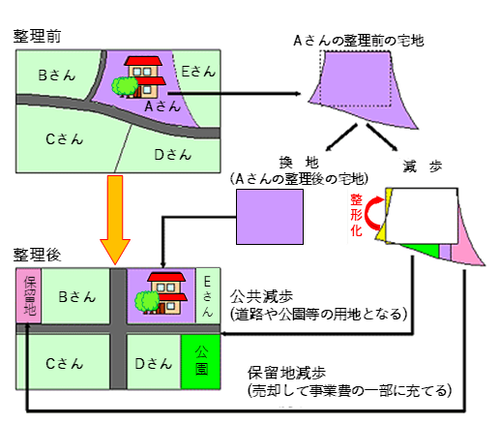Here's the text.
Business Structure
Last Updated September 30, 2024
The land readjustment project obtains land little by little from the right holders in the district as "reduction of walking" according to their rights.
Of this reduction, land to be allocated to land for public facilities such as roads and parks that are newly maintained and improved is called "public reduction". In this way, we will maintain the necessary public facilities in the area.
In addition, the land to be allocated to the “reserved land” for sale is called “reserved land reduction”, and by selling the reserved land, it will be allocated to a part of the business fund.
In the district, public facilities and residential land will be comprehensively organized, and the right holder will use a new "replacement" after the project. At the final stage of the project, "replacement disposal" will be performed to register new residential land all at once.

Land readjustment project as a method of base development
The land readjustment project is a method that enables flexible business development that matches the various actual conditions of the region, and is used in many districts as a representative method of urban area maintenance.
In Yokohama City, land readjustment projects have formed new regional bases in areas such as "Kohoku New Town" and "Minato Mirai 21".
In addition, public facilities such as station squares and city planning roads are improved by land readjustment projects around the station, and the designated floor area ratio of restricted zones and buildings is changed in shaped residential lands, and the value of use is further improved. Town development suitable for the station square is being carried out.
Land readjustment project as a maintenance method for urban planning roads
In the land readjustment project, by including residential land outside the city planning road area in the land readjustment project area, at the same time as the maintenance of city planning roads, the development of residential land along the road and the necessary division roads will be maintained. It is possible to do. As a result, it is possible to rebuild life in the same area as before the project, and there are advantages such as not creating irregular land that is difficult to use along the road.
[Related Explanation]
Compensation for rights holders
Business income and expenditure (financial plan)
| Question | Answer |
|---|---|
| What will happen to residential land and buildings owned in the district before the project? | While considering the conditions of the previous residential land, we will relocate the residential land as a "replacement" to make it easier to use. In the event of an economic loss due to the removal of a building or relocation outside the district, compensation will be paid for the loss that normally occurs. |
| What happens to people who lived in rental housing in the district? | After the start of the business, you will need to relocate from the rental housing. Upon transfer, compensation will be paid for any loss that would normally occur. |
| If a person who lived in the district before the business lives in the district after the business, where do you live during the business? | Due to the temporary replacement lot designation, you will not be able to use the existing residential land and you will be able to use the temporary replacement lot, so you will build a new house on the temporary replacement lot and move it. If both the previous residential land and the temporary replacement lot cannot be used due to the progress of the construction, you may be required to temporarily relocate to a temporary residence outside the district until the temporary replacement lot can be used. |
| What will happen to stores operating in the district before the business? | If it is deemed necessary to temporarily suspend operations in the building due to the relocation of the building, the suspension of operations will be compensated for the decrease in revenue during the relocation period and the amount equivalent to the leave allowance of employees. |
| What are the financial resources of the business funds required for the business? | The land provided by the right holders in the district as "reduction of walking" little by little as "reduction" will be allocated to the reserved land, and the reserved land will be used to part of the business fund. In addition, we may be able to utilize subsidies of the national and local governments. |
| Who owns and manages the roads and parks maintained in the project? | Roads and parks are managed by the national or local governments as the owners of the land and facilities. Therefore, it is necessary to maintain a standard suitable for each facility. |
| How long will it take to complete the project? | Depending on the number of right holders and the size of the business, including pre-business study sessions and planning considerations, it may take more than 10 years to investigate, design, construction, and land replacement after the start of the business. |
Business Law
The land readjustment project is a project conducted based on the law called the Land Readjustment Act (Law No. 119 of 1954). In order to protect the property of the relevant right holders, the Land Readjustment Act stipulates procedures for fair and fair progress of the project, such as requiring the approval of the The Mayor of Yokohama at each stage of the project and seeking consent and opinions from the deliberative body.
Inquiries to this page
Urban Development Coordination Division, Urban Development Bureau Urban Development Department
Telephone: 045-671-2695
Telephone: 045-671-2695
Fax: 045-664-7694
Email address: tb-seibichosei@city.yokohama.lg.jp
Page ID: 390-399-863







